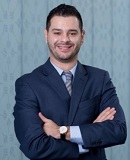
Asso. Prof. Hoshang Kolivand
Liverpool John Moores University, UK
Title: Augmented and Virtual Reality in AI
Abstract: There is no doubt that Augmented and Virtual Reality (AR/VR) has changed the world recently and has the potential to become a fascinating widespread requirement in daily life. In about two decades, AR/VR has turned into one of the most attractive topics involved in a variety of topics attempting to obtain satisfactory results. Artificial Intelligence (AI) and AR/VR are changing everything with the help of Data Science and Machine Learning. We are going to face a new world that AI will be the heart of, and AR/VR its eyes. In this speech, I am going to present what I have done so far with AR and VR. Current advances and future directions of AR/VR and wearable devices will be discussed with respect to AI. At the end revenue of this technology will be discussed.

Asso. Prof. T. Velmurugan
University of Madras, India
Title: Enhancement of Cloud Security using Secure Hashing Algorithm 384 and Message Digest Authentication
Abstract: Cloud Computing provides a powerful depository platform that enables business and individual users to accomplish various stages of tasks such as the use of applications, adoption of cloud advertisements, expansion of customized computer package, and creation of a authenticate network. This research work carried out to improve the security of the end-users using a Secured Hashing Algorithm 384 (SHA 384) and Message Digest Authentication (MDA). This work suggests a new solution for the concern that is getting raised the data privacy. The usage of the Message Digest Authentication algorithm helps to develop a platform that ensures data security and reduce the data breach problem for the end user in the cloud environment. For that, the Message Digest Authentication is taken and implemented by a practical approach in the cloud environment. In this research work, it is proposed to use a new level of data security solution using Secure Hashing Algorithm 384 and Message Digest Authentication algorithm. Both the algorithms are encrypted by the full set of 256 ASCII characters. The major software tool called Software Defined Network (SDN) is used to identify the attacks faced by the end-user. From the experimental results, it is identified that the best algorithm to protect the data. The main aim of this research work is to clarify the security issues in both cloud providers and cloud consumers using cryptography encryption methods.

Dr. Tao Lin
Google, USA
Title: Challenges of Deep Learning in Software Engineering
Abstract: There are increasingly deep learning approaches being used in software engineering domain. While, there are no agreement on how to adopt deep learning in this new domain. This speech presents methodological principles for deep learning in software engineering. Firstly, this work summarizes how to evaluate deep learning results in software engineering. Secondly, this speech suggests methodological principles that can be used in this new scenario. We construct these methodological principles as a guideline for deep learning research in software engineering.

Dr. Yanjiao Chen
Zhejiang University, China
Speech Title: FakeWake: Understanding and Mitigating Fake Wake-up Words of Voice Assistants
Abstract: Smart voice assistants are widely distributed in the Internet of Things. However, smart voice assistants may be activated by non-wake-up words, posing a threat to users' privacy. This talk will systematically introduce the phenomenon of Fakewake, the structure of fuzzy words, and the preventive measures for fakewake.

Prof. Nick Freris
University of Science and Technology of China, China
Speech Title: Communication-efficient distributed machine learning for AIoT
Abstract: The ever-emerging paradigm of AIoT targets solutions that capitalize on the computational power of Internet-of-Things (IoT) devices to enable Artificial Intelligence (AI) in system operations. This is accomplished by shifting away from centralized cloud computing to decentralized edge computing. To this end, distributed optimization is the workhorse tool for machine learning in a multi-agent network. Despite the large body of work on the subject, it is imperative to devise new methods tailored to address the distinctive challenges of AIoT systems such as: a) huge-scale, b) stringent constraints on communication and latency, and c) heterogeneity in terms of device computational capabilities as well as data distributions. This keynote seminar will present a novel framework for distributed optimization based on operator splitting that specifically targets communication efficiency and adaptability to user heterogeneity. The product is a range of asynchronous algorithms (first and second order) for both convex and non-convex problems with rigorous analysis in terms of convergence rate and communication costs. In particular, I will present a new method for federated learning (distributed deep learning in large heterogeneous networks) with state-of-the-art performance in terms of convergence speed, communication savings, and accuracy.

Prof. Hong Huang
Chongqing University, China
Speech Title: Scene classification of Remote Sensing Images Based on Deep learning
Abstract: Remote sensing image scene classification, which aims at labeling remote sensing images with a set of semantic categories based on their contents, has broad applications in a range of fields. remote sensing images have the characteristics of diversity of ground objects, complex background interference, changeable ground objects of the same type, rich spatial patterns, and high homogeneity between ground objects, resulting in the challenges of high inter-class similarity and intra-class differences in scenes. Therefore, it is necessary to extract more discriminative scene-level semantic features to improve the classification accuracy. This talk focuses on scene deep semantic feature expression based on deep learning and transfer learning theory, and scene classification methods are developed from four levels, including deep coding feature learning, global-local structure exploration, contextual semantic understanding, and spatial-spectral joint representation.

Prof. Len Gelman
University of Huddersfield, UK
Speech Title: Novel higher order signal processing for vibro-acoustical condition monitoring
Abstract: The classical higher order signal processing, that are employed for condition monitoring, will be discussed. Important future directions of higher order signal processing for condition monitoring will be presented for application in transient conditions:
• new type of non-stationary adaptive spectral transforms
• new type of non-stationary non-adaptive spectral transforms
• new type of non-adaptive and adaptive frequency response functions
Validation of these novel techniques by simulation and experiments in laboratory and field conditions will also be presented. It is shown. that the proposed transforms deliver an essential improvement in effectiveness of vibro-acoustical condition monitoring, comparing to the traditional transforms.

Prof. Xiaodong Liu
Edinburgh Napier University, UK
Speech Title: Challenges in the Next Generation IoT and Context-Active Resilience in Cyber Physical Systems
Abstract: Cyber-physical systems (CPS) refer to novel hardware and software compositions creating smart, autonomously acting devices, enabling efficient end-to-end workflows and new forms of user-machine interaction. A resilient CPS system is one that maintains state awareness and an accepted level of operational normalcy in response to disturbances, including threats of an unexpected and malicious nature. Due to its interdisciplinary and sophisticated nature, although resilience is critically desired in CPS, existing approaches and tools are only able to support limited resilience in a non-dynamic manner, i.e., fail to consider and respond to a comprehensive profile of the current states and needs of the devices and human users, which are always dynamically changing during the running of a CPS. We define such a profile as the context of a CPS, and advocate that a CPS should adapt itself actively and even proactively for the optimal functions and Quality of Services (QoS) according to this dynamic context. This is a new level of resilience, which has not been aimed at by previous work, and we define it as “Context-Active Resilience (CAR)”. We aim to develop a novel approach to context-active resilience in CPS, which ensures the best matching and optimal functions and QoS of the CPS in real-time during the running of the CPS.

Paweł Skrzypek
AI Investments, Poland

Alicja Reniewicz
MELODIC Enterprise, Poland
Speech Title: Autonomous Multi-Cloud serverless deployment and optimized management
Abstract: The dynamic development of Cloud Computing with the introduction of novel Cloud computing models like serverless creates new challenges for Cloud deployment. This presentation describes how to implement Multi-Cloud native strategies using advanced an open source framework that allows for Cloud-agnostic Multi-Cloud deployment and optimized management of the serverless applications based on flexible monitoring, context aware maximization of the application owner’s utility of the deployed serverless components, and autonomic reconfiguration based on the application’s current execution context. All stages of the cloud deployment planning and designing process will be shown. Also, the key execution steps will be provided.